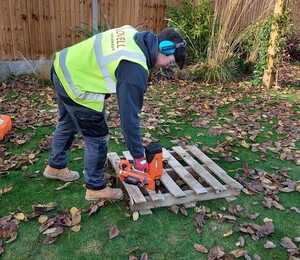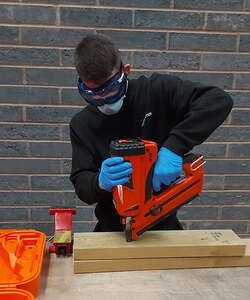Nail Gun Training
13 Essential Nail Gun Safety Tips Every Operator Must Know
Nail guns are handy tools, making tasks like framing and roofing faster and more efficient. However, their power and precision also make nail guns dangerous if not used correctly.
Nail gun injuries are more common than you might think, with thousands of accidents reported each year. Whether you’re a professional contractor or a DIY enthusiast, safety must always be the top priority.
Here are 13 essential nail gun safety tips every operator must know to ensure a safe and efficient work environment.
Understand the Tool Before Use
Before picking up a nail gun, take the time to read the manufacturer’s instruction manual. Familiarise yourself with the tool’s components, operating mechanism, and safety features. Different models have varying functionalities, so understanding your specific nail gun is crucial.
Wear the Correct Safety Gear
Personal protective equipment (PPE) is essential when operating a nail gun. At a minimum, you should wear:
- Safety goggles, face shield, and safety glasses to protect your eyes from flying debris or misfired nails.
- Hearing protection such as ear plugs or ear defenders, especially for pneumatic or gas-powered nail guns.
- Gloves to maintain a good grip and shield your hands.
Inspect the Nail Gun Regularly
Before each use, check your nail gun for:
- Loose screws or parts
- Air leaks in pneumatic models
- Signs of wear and tear on hoses and power connections.
Regular maintenance reduces the risk of malfunctions and accidents.
Use the Correct Nails
Always use nails that are compatible with your nail gun. Mismatched nails can cause jams, misfires, or tool damage, leading to potential injuries. Check the instruction manual or product specifications for the right size and type of nails.
Engage the Safety Mechanism
Modern nail guns are equipped with safety features, such as a contact trip mechanism or sequential trigger. Sequential triggers are safer, as they require the operator to press the safety tip against the surface before pulling the trigger. Avoid disabling or bypassing these safety mechanisms, it’s not worth the risk.

Keep Fingers and Hands Clear
Never place your hands or fingers in the line of fire. Even if you think the tool is off or inactive, a misfire could occur. Always hold the tool with both hands and maintain control during operation.
Avoid Carrying a Nail Gun with Your Finger on the Trigger
Walking around with your finger on the trigger increases the risk of accidental firing. Always engage the safety mechanism when moving between tasks and carry the nail gun by its handle.
Maintain a Stable Work Surface
Ensure that the surface you’re nailing into is stable and secure. An unstable workpiece can cause the nail gun to recoil unpredictably, leading to inaccurate shots or injuries.
Store the Nail Gun Safely
When not in use, disconnect the nail gun from its power source (air compressor, battery, or cord) and store it in a secure location.
Be Aware of Surroundings
Accidents often happen when operators are unaware of their environment. Keep your work area clear of distractions, and make sure no one is in the line of fire. Alert nearby workers about your activity to avoid surprises.

Take Breaks to Avoid Fatigue
Operating a nail gun for extended periods can lead to fatigue, which increases the likelihood of mistakes. Take regular breaks to stay alert and maintain focus on the task at hand.
Know How to Handle Jams
If your nail gun jams, don’t attempt to fix it hastily. Turn off and disconnect the tool before clearing the jam to avoid accidental firing.
Receive Proper Training
If you’re new to using a nail gun, consider taking a nail gun training session. Knowing how to use the tool correctly can prevent many common accidents.
Final Thoughts
Safety should always come first when operating a nail gun. By following these essential tips, you can significantly reduce the risk of injuries and ensure a smoother, more efficient work process. Remember, even the most experienced operators must stay vigilant and prioritise safety at all times.


